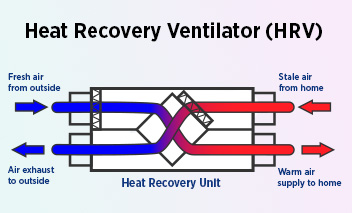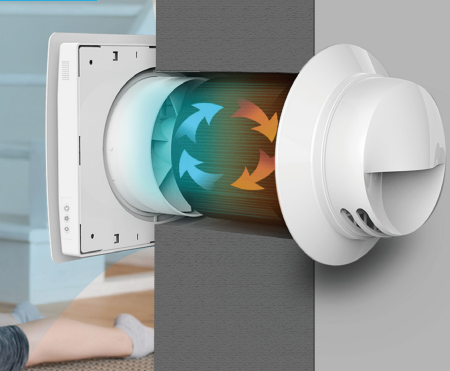The All-Inclusive Guide to the Uses of Heat Recovery Ventilation in Modern Structures
Heat Recovery Ventilation (HRV) systems represent a considerable innovation in developing innovation (HRV Heat Recovery Ventilation). They supply a technique for exchanging stagnant indoor air with fresh outside air while minimizing energy loss. This strategy not only enhances indoor air high quality yet additionally adds to power performance in both domestic and business buildings. Comprehending the various applications and benefits of HRV can reveal its important duty in contemporary layout and sustainability efforts. The implications of this modern technology are worth checking out even more
Recognizing Heat Recovery Ventilation Systems

Although numerous modern-day structures focus on energy efficiency, recognizing warmth recovery ventilation (HRV) systems is vital for enhancing indoor air top quality and reducing power consumption. HRV systems work by moving heat from stagnant interior air to incoming fresh air, effectively keeping comfy interior temperature levels while reducing power loss. These systems consist of a warmth exchanger, followers, and ductwork that facilitate the circulation of air. Throughout winter months, HRV devices capture and recycle warm from the outgoing air, while in summer season, they can assist cool down inbound air. By continuously trading air, HRV systems likewise minimize moisture and the focus of indoor toxins. Proper installation and maintenance of HRV systems are essential for their efficiency and performance in improving overall structure performance and comfort.
Benefits of Heat Recovery Ventilation
Heat recovery ventilation systems provide numerous benefits that boost both energy effectiveness and indoor air quality in modern buildings. By catching and recycling energy from exhaust air, these systems considerably lower home heating and air conditioning expenses, leading to reduced power usage. In addition, they keep a consistent flow of fresh exterior air, decreasing the danger of indoor air contaminants and allergens. This continuous exchange assists control moisture degrees, protecting against mold and mildew development and making sure a much healthier living setting. In addition, HRV systems add to sustainability goals by lowering total carbon footprints. Their capability to enhance air flow without sacrificing thermal comfort makes them a valuable enhancement to modern structure design, promoting both economic and eco-friendly benefits.
Applications of HRV in Residential Buildings
As house owners increasingly focus on energy effectiveness and indoor air top quality, the applications of heat healing air flow (HRV) systems in property buildings have actually come to be more prevalent. HRV systems are particularly useful in snugly sealed homes, where maintaining fresh air flow is crucial for preventing moisture accumulation and interior contaminants. They properly move warmth from outward bound stagnant air to inbound fresh air, lowering power costs related to cooling and heating. Additionally, HRVs can improve comfort degrees by managing moisture and temperature. They are also adaptable for different domestic styles, including single-family homes and multi-unit buildings. In general, integrating HRV systems sustains sustainable living practices while guaranteeing a much healthier interior environment for residents.
HRV in Commercial and Commercial Setups
In commercial and commercial setups, the execution of heat recovery ventilation (HRV) systems has actually become progressively important for optimizing energy performance and preserving air high quality. These systems successfully move warm from exhaust air to inbound fresh air, lowering the demand for additional heating or cooling. This not only lowers energy expenses yet also adds to sustainability initiatives. Industries such as manufacturing, warehousing, and office complex benefit greatly from HRV systems, as they aid control temperature and humidity degrees, guaranteeing a comfortable and effective environment. Furthermore, HRV systems help in removing impurities and excess wetness, boosting interior air high quality. As guidelines around air quality end up being more stringent, the adoption of HRV modern technology is most likely to grow, making it a crucial part of contemporary commercial and industrial framework.
Future Trends in Heat Recovery Ventilation Modern Technology

Often Asked Inquiries
Exactly How Does Heat Recovery Ventilation Influence Indoor Air Top Quality?
Heat recovery ventilation substantially enhances indoor air quality by continuously exchanging stale indoor air with fresh outside air while recovering energy. This process reduces pollutants, preserves optimal humidity levels, and guarantees a healthier environment for passengers.
Can HRV Solutions Be Installed in Existing Structures?
HRV systems can undoubtedly be set up in existing structures. Retrofitting may require alterations to ductwork and ventilation layouts, but it substantially boosts energy effectiveness and indoor air high quality, making it a sensible option for older structures.
What Upkeep Is Required for HRV Solutions?

Exist Details Climates Where HRV Is More Reliable?
Heat recovery ventilation systems are particularly effective in climates with significant temperature level differences in between seasons. These systems enhance energy effectiveness by recouping warm from exhaust air, making them excellent for both chilly and reasonably cozy atmospheres.
Exactly How Do HRV Equipments Affect Power Costs?
